Ratio & Cash Flow Analysis: A Financial Statement Analysis of Metcash
VerifiedAdded on 2023/06/08
|18
|3950
|276
Report
AI Summary
This report presents a comprehensive financial statement analysis of Metcash over five years (2014-2018), focusing on ratio and cash flow analysis. It includes reformatted financial statements and an in-depth discussion of key ratios such as Return on Equity (ROE), Return on Net Operating Assets (RNOA), Financial Leverage (FLEV), Net Borrowing Cost (NBC), and Asset Turnover (ATO). The analysis breaks down Profit Margin (PM) and ATO ratios, identifying significant expense items affecting profit margins and major assets/liabilities influencing asset efficiency. Furthermore, the report assesses Metcash's liquidity, solvency, and cash flow management, highlighting trends in current, quick, and cash ratios, as well as financial stability indicators like interest coverage and net financial liabilities. The analysis integrates economic, industry, and business factors driving the changes in these financial metrics. The document is available on Desklib, a platform offering a wide range of study resources for students.
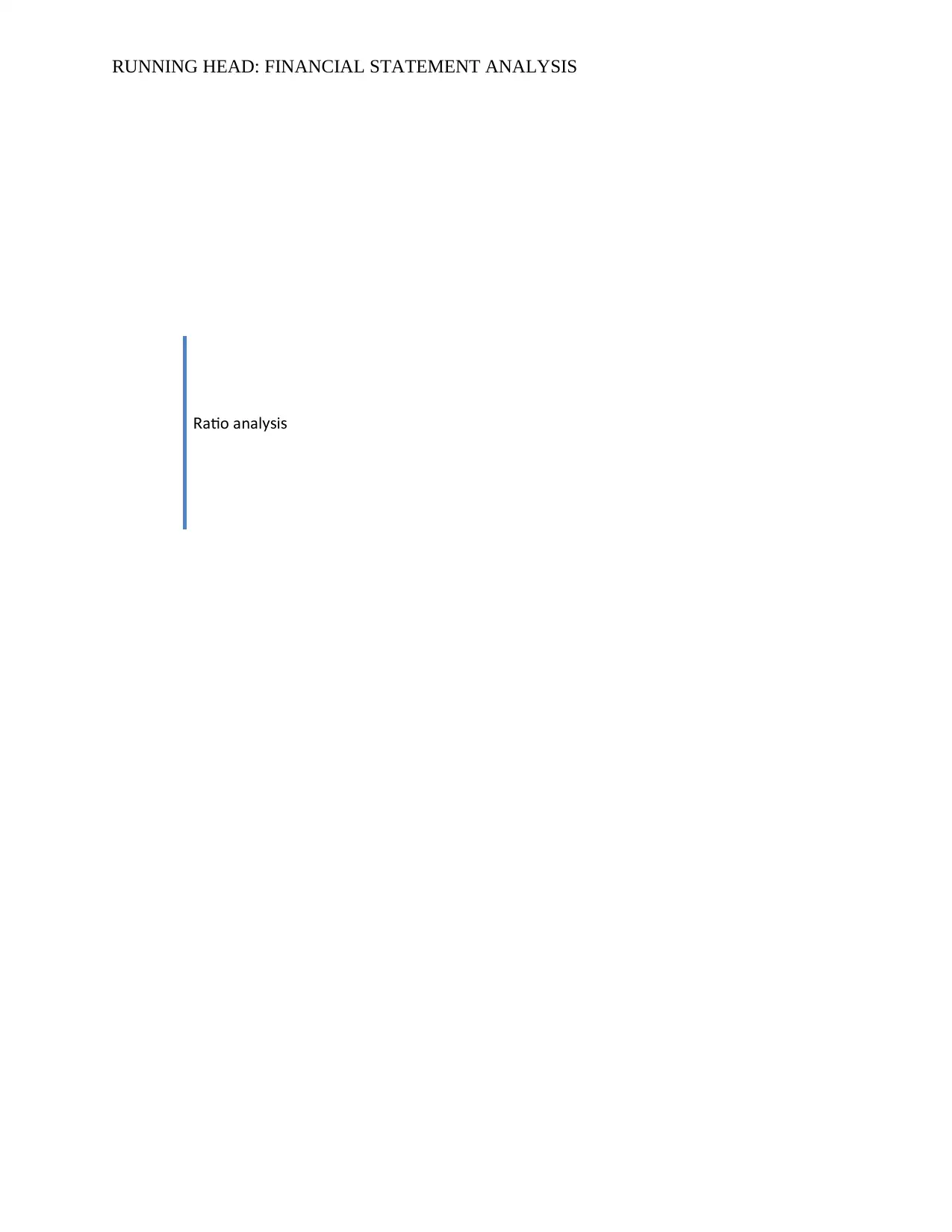
RUNNING HEAD: FINANCIAL STATEMENT ANALYSIS
atio anal iR ys s
atio anal iR ys s
Paraphrase This Document
Need a fresh take? Get an instant paraphrase of this document with our AI Paraphraser
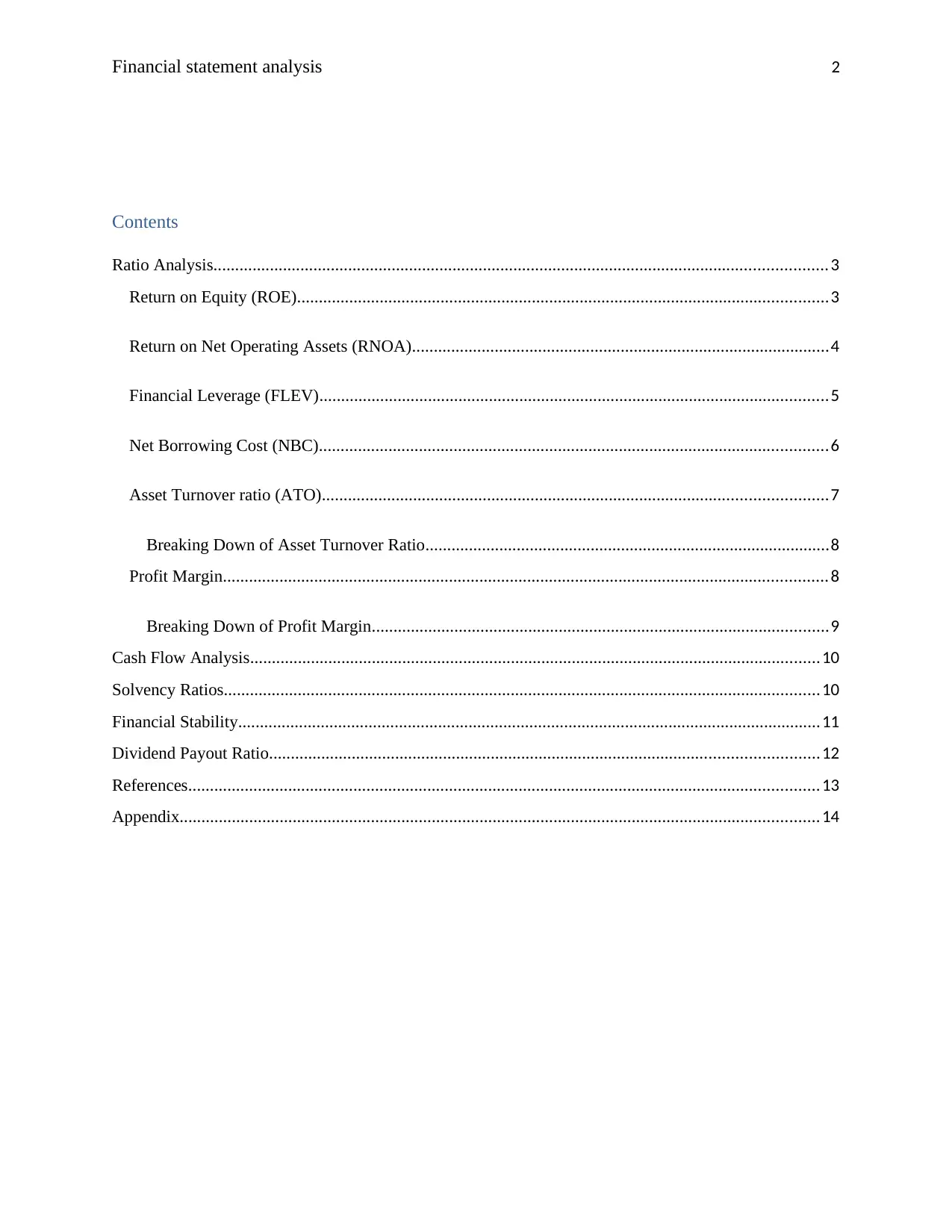
Financial statement analysis 2
Contents
Ratio Analysis.............................................................................................................................................3
Return on Equity (ROE)..........................................................................................................................3
Return on Net Operating Assets (RNOA)................................................................................................4
Financial Leverage (FLEV).....................................................................................................................5
Net Borrowing Cost (NBC).....................................................................................................................6
Asset Turnover ratio (ATO)....................................................................................................................7
Breaking Down of Asset Turnover Ratio.............................................................................................8
Profit Margin...........................................................................................................................................8
Breaking Down of Profit Margin.........................................................................................................9
Cash Flow Analysis...................................................................................................................................10
Solvency Ratios.........................................................................................................................................10
Financial Stability......................................................................................................................................11
Dividend Payout Ratio..............................................................................................................................12
References.................................................................................................................................................13
Appendix...................................................................................................................................................14
Contents
Ratio Analysis.............................................................................................................................................3
Return on Equity (ROE)..........................................................................................................................3
Return on Net Operating Assets (RNOA)................................................................................................4
Financial Leverage (FLEV).....................................................................................................................5
Net Borrowing Cost (NBC).....................................................................................................................6
Asset Turnover ratio (ATO)....................................................................................................................7
Breaking Down of Asset Turnover Ratio.............................................................................................8
Profit Margin...........................................................................................................................................8
Breaking Down of Profit Margin.........................................................................................................9
Cash Flow Analysis...................................................................................................................................10
Solvency Ratios.........................................................................................................................................10
Financial Stability......................................................................................................................................11
Dividend Payout Ratio..............................................................................................................................12
References.................................................................................................................................................13
Appendix...................................................................................................................................................14
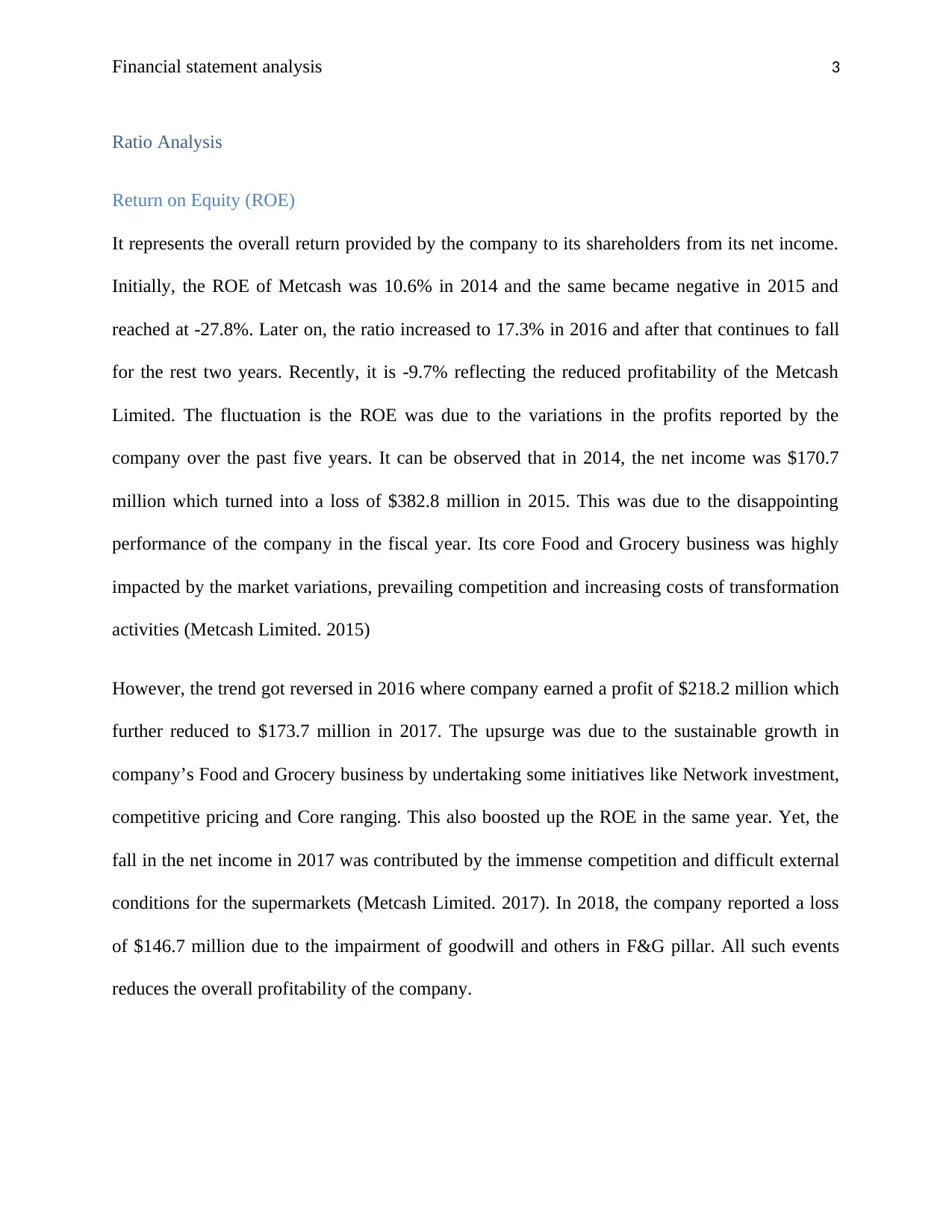
Financial statement analysis 3
Ratio Analysis
Return on Equity (ROE)
It represents the overall return provided by the company to its shareholders from its net income.
Initially, the ROE of Metcash was 10.6% in 2014 and the same became negative in 2015 and
reached at -27.8%. Later on, the ratio increased to 17.3% in 2016 and after that continues to fall
for the rest two years. Recently, it is -9.7% reflecting the reduced profitability of the Metcash
Limited. The fluctuation is the ROE was due to the variations in the profits reported by the
company over the past five years. It can be observed that in 2014, the net income was $170.7
million which turned into a loss of $382.8 million in 2015. This was due to the disappointing
performance of the company in the fiscal year. Its core Food and Grocery business was highly
impacted by the market variations, prevailing competition and increasing costs of transformation
activities (Metcash Limited. 2015)
However, the trend got reversed in 2016 where company earned a profit of $218.2 million which
further reduced to $173.7 million in 2017. The upsurge was due to the sustainable growth in
company’s Food and Grocery business by undertaking some initiatives like Network investment,
competitive pricing and Core ranging. This also boosted up the ROE in the same year. Yet, the
fall in the net income in 2017 was contributed by the immense competition and difficult external
conditions for the supermarkets (Metcash Limited. 2017). In 2018, the company reported a loss
of $146.7 million due to the impairment of goodwill and others in F&G pillar. All such events
reduces the overall profitability of the company.
Ratio Analysis
Return on Equity (ROE)
It represents the overall return provided by the company to its shareholders from its net income.
Initially, the ROE of Metcash was 10.6% in 2014 and the same became negative in 2015 and
reached at -27.8%. Later on, the ratio increased to 17.3% in 2016 and after that continues to fall
for the rest two years. Recently, it is -9.7% reflecting the reduced profitability of the Metcash
Limited. The fluctuation is the ROE was due to the variations in the profits reported by the
company over the past five years. It can be observed that in 2014, the net income was $170.7
million which turned into a loss of $382.8 million in 2015. This was due to the disappointing
performance of the company in the fiscal year. Its core Food and Grocery business was highly
impacted by the market variations, prevailing competition and increasing costs of transformation
activities (Metcash Limited. 2015)
However, the trend got reversed in 2016 where company earned a profit of $218.2 million which
further reduced to $173.7 million in 2017. The upsurge was due to the sustainable growth in
company’s Food and Grocery business by undertaking some initiatives like Network investment,
competitive pricing and Core ranging. This also boosted up the ROE in the same year. Yet, the
fall in the net income in 2017 was contributed by the immense competition and difficult external
conditions for the supermarkets (Metcash Limited. 2017). In 2018, the company reported a loss
of $146.7 million due to the impairment of goodwill and others in F&G pillar. All such events
reduces the overall profitability of the company.
⊘ This is a preview!⊘
Do you want full access?
Subscribe today to unlock all pages.

Trusted by 1+ million students worldwide
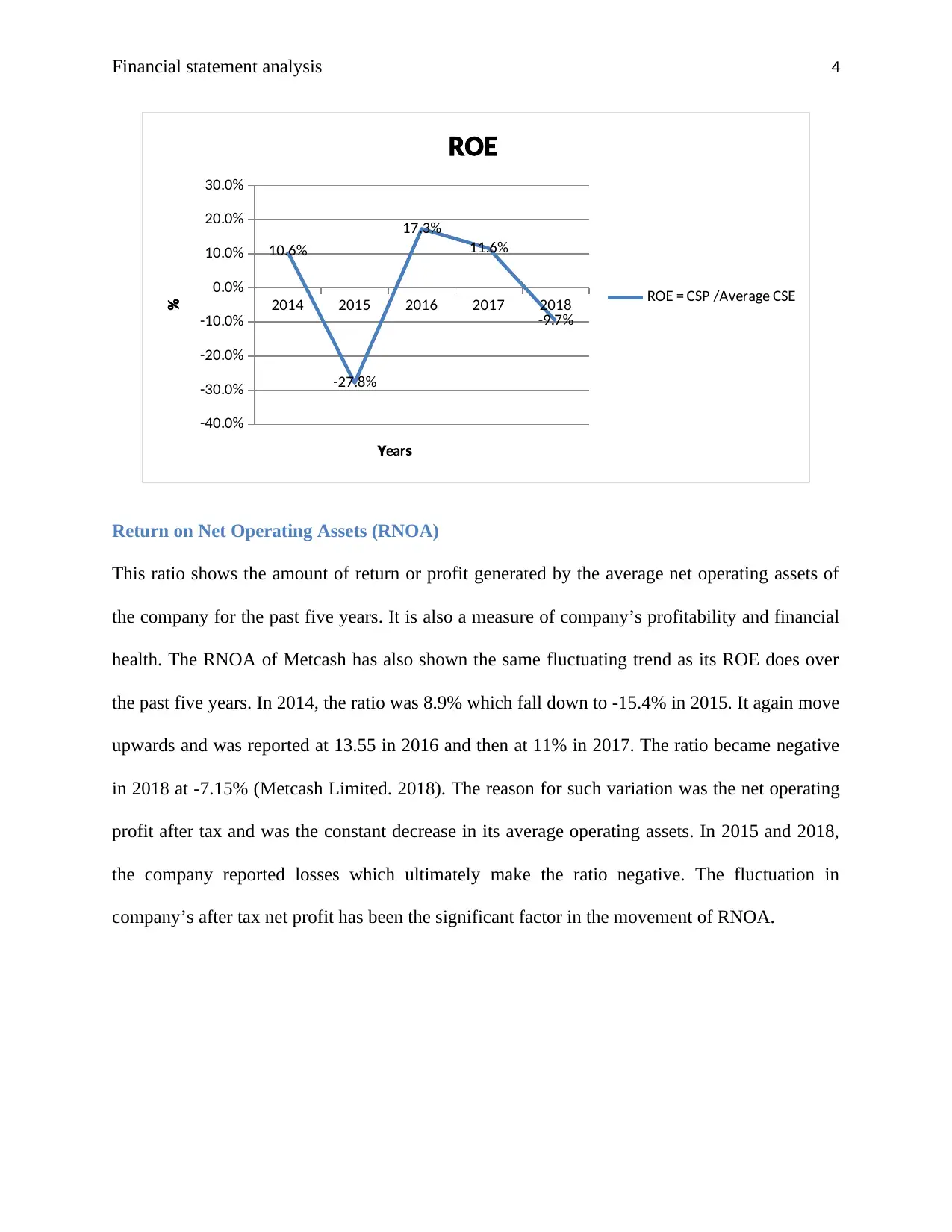
Financial statement analysis 4
2014 2015 2016 2017 2018
-40.0%
-30.0%
-20.0%
-10.0%
0.0%
10.0%
20.0%
30.0%
10.6%
-27.8%
17.3%
11.6%
-9.7%
ROE
P A era eROE = CS / v g CSE
earY s
%
Return on Net Operating Assets (RNOA)
This ratio shows the amount of return or profit generated by the average net operating assets of
the company for the past five years. It is also a measure of company’s profitability and financial
health. The RNOA of Metcash has also shown the same fluctuating trend as its ROE does over
the past five years. In 2014, the ratio was 8.9% which fall down to -15.4% in 2015. It again move
upwards and was reported at 13.55 in 2016 and then at 11% in 2017. The ratio became negative
in 2018 at -7.15% (Metcash Limited. 2018). The reason for such variation was the net operating
profit after tax and was the constant decrease in its average operating assets. In 2015 and 2018,
the company reported losses which ultimately make the ratio negative. The fluctuation in
company’s after tax net profit has been the significant factor in the movement of RNOA.
2014 2015 2016 2017 2018
-40.0%
-30.0%
-20.0%
-10.0%
0.0%
10.0%
20.0%
30.0%
10.6%
-27.8%
17.3%
11.6%
-9.7%
ROE
P A era eROE = CS / v g CSE
earY s
%
Return on Net Operating Assets (RNOA)
This ratio shows the amount of return or profit generated by the average net operating assets of
the company for the past five years. It is also a measure of company’s profitability and financial
health. The RNOA of Metcash has also shown the same fluctuating trend as its ROE does over
the past five years. In 2014, the ratio was 8.9% which fall down to -15.4% in 2015. It again move
upwards and was reported at 13.55 in 2016 and then at 11% in 2017. The ratio became negative
in 2018 at -7.15% (Metcash Limited. 2018). The reason for such variation was the net operating
profit after tax and was the constant decrease in its average operating assets. In 2015 and 2018,
the company reported losses which ultimately make the ratio negative. The fluctuation in
company’s after tax net profit has been the significant factor in the movement of RNOA.
Paraphrase This Document
Need a fresh take? Get an instant paraphrase of this document with our AI Paraphraser
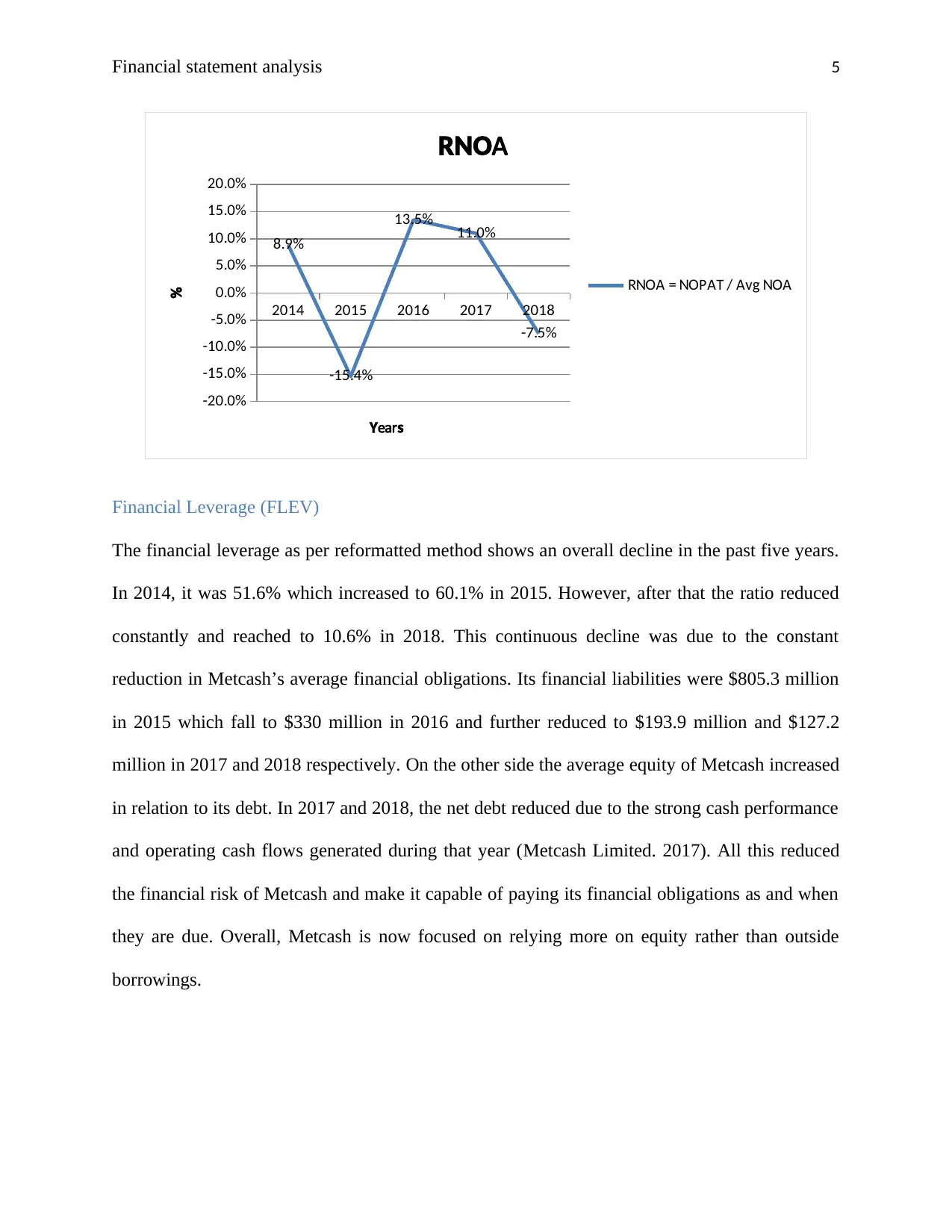
Financial statement analysis 5
2014 2015 2016 2017 2018
-20.0%
-15.0%
-10.0%
-5.0%
0.0%
5.0%
10.0%
15.0%
20.0%
8.9%
-15.4%
13.5% 11.0%
-7.5%
ARNO
A PAT A ARNO = NO / vg NO
earY s
%
Financial Leverage (FLEV)
The financial leverage as per reformatted method shows an overall decline in the past five years.
In 2014, it was 51.6% which increased to 60.1% in 2015. However, after that the ratio reduced
constantly and reached to 10.6% in 2018. This continuous decline was due to the constant
reduction in Metcash’s average financial obligations. Its financial liabilities were $805.3 million
in 2015 which fall to $330 million in 2016 and further reduced to $193.9 million and $127.2
million in 2017 and 2018 respectively. On the other side the average equity of Metcash increased
in relation to its debt. In 2017 and 2018, the net debt reduced due to the strong cash performance
and operating cash flows generated during that year (Metcash Limited. 2017). All this reduced
the financial risk of Metcash and make it capable of paying its financial obligations as and when
they are due. Overall, Metcash is now focused on relying more on equity rather than outside
borrowings.
2014 2015 2016 2017 2018
-20.0%
-15.0%
-10.0%
-5.0%
0.0%
5.0%
10.0%
15.0%
20.0%
8.9%
-15.4%
13.5% 11.0%
-7.5%
ARNO
A PAT A ARNO = NO / vg NO
earY s
%
Financial Leverage (FLEV)
The financial leverage as per reformatted method shows an overall decline in the past five years.
In 2014, it was 51.6% which increased to 60.1% in 2015. However, after that the ratio reduced
constantly and reached to 10.6% in 2018. This continuous decline was due to the constant
reduction in Metcash’s average financial obligations. Its financial liabilities were $805.3 million
in 2015 which fall to $330 million in 2016 and further reduced to $193.9 million and $127.2
million in 2017 and 2018 respectively. On the other side the average equity of Metcash increased
in relation to its debt. In 2017 and 2018, the net debt reduced due to the strong cash performance
and operating cash flows generated during that year (Metcash Limited. 2017). All this reduced
the financial risk of Metcash and make it capable of paying its financial obligations as and when
they are due. Overall, Metcash is now focused on relying more on equity rather than outside
borrowings.
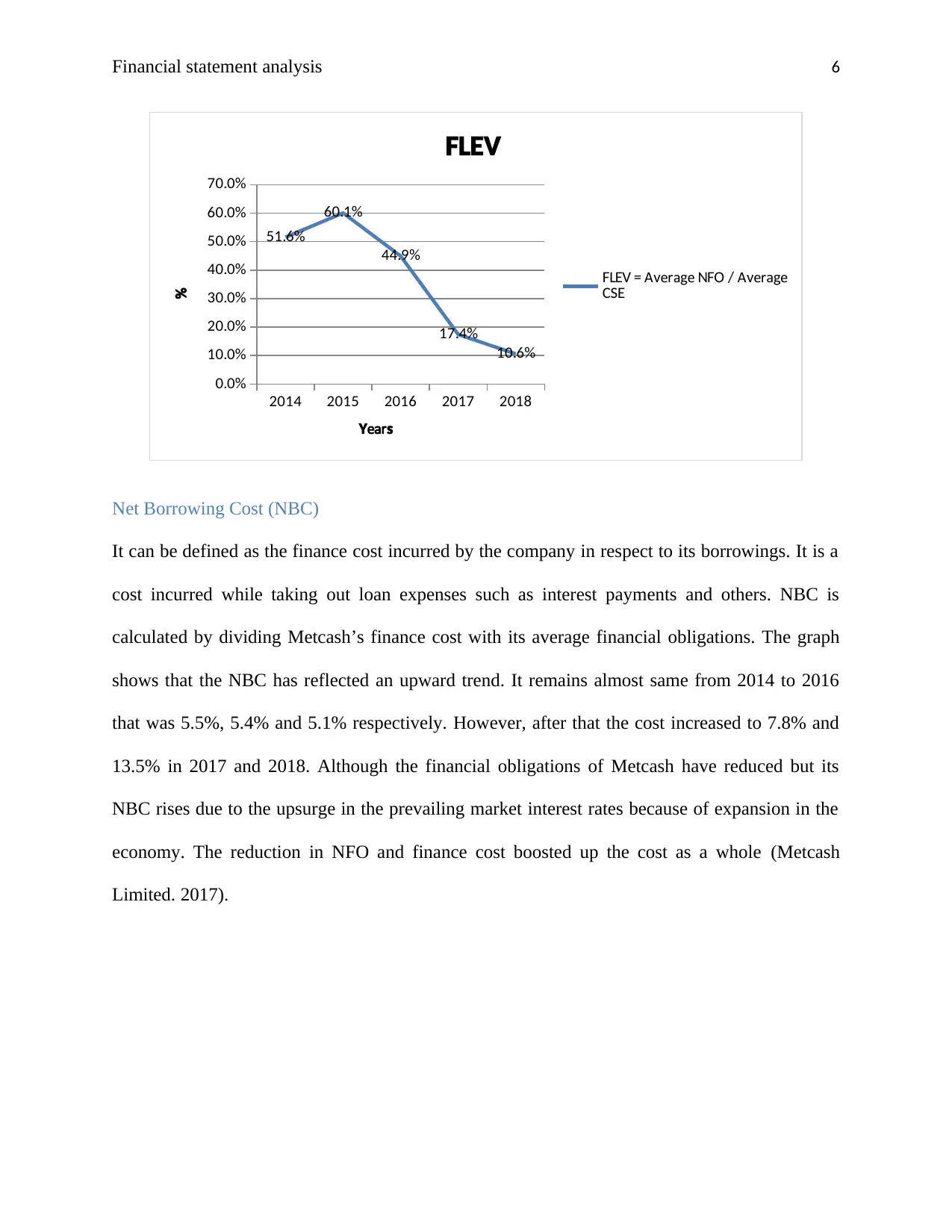
Financial statement analysis 6
2014 2015 2016 2017 2018
0.0%
10.0%
20.0%
30.0%
40.0%
50.0%
60.0%
70.0%
51.6%
60.1%
44.9%
17.4%
10.6%
FLEV
A era e A era eFLEV = v g NFO / v g
CSE
earY s
%
Net Borrowing Cost (NBC)
It can be defined as the finance cost incurred by the company in respect to its borrowings. It is a
cost incurred while taking out loan expenses such as interest payments and others. NBC is
calculated by dividing Metcash’s finance cost with its average financial obligations. The graph
shows that the NBC has reflected an upward trend. It remains almost same from 2014 to 2016
that was 5.5%, 5.4% and 5.1% respectively. However, after that the cost increased to 7.8% and
13.5% in 2017 and 2018. Although the financial obligations of Metcash have reduced but its
NBC rises due to the upsurge in the prevailing market interest rates because of expansion in the
economy. The reduction in NFO and finance cost boosted up the cost as a whole (Metcash
Limited. 2017).
2014 2015 2016 2017 2018
0.0%
10.0%
20.0%
30.0%
40.0%
50.0%
60.0%
70.0%
51.6%
60.1%
44.9%
17.4%
10.6%
FLEV
A era e A era eFLEV = v g NFO / v g
CSE
earY s
%
Net Borrowing Cost (NBC)
It can be defined as the finance cost incurred by the company in respect to its borrowings. It is a
cost incurred while taking out loan expenses such as interest payments and others. NBC is
calculated by dividing Metcash’s finance cost with its average financial obligations. The graph
shows that the NBC has reflected an upward trend. It remains almost same from 2014 to 2016
that was 5.5%, 5.4% and 5.1% respectively. However, after that the cost increased to 7.8% and
13.5% in 2017 and 2018. Although the financial obligations of Metcash have reduced but its
NBC rises due to the upsurge in the prevailing market interest rates because of expansion in the
economy. The reduction in NFO and finance cost boosted up the cost as a whole (Metcash
Limited. 2017).
⊘ This is a preview!⊘
Do you want full access?
Subscribe today to unlock all pages.

Trusted by 1+ million students worldwide
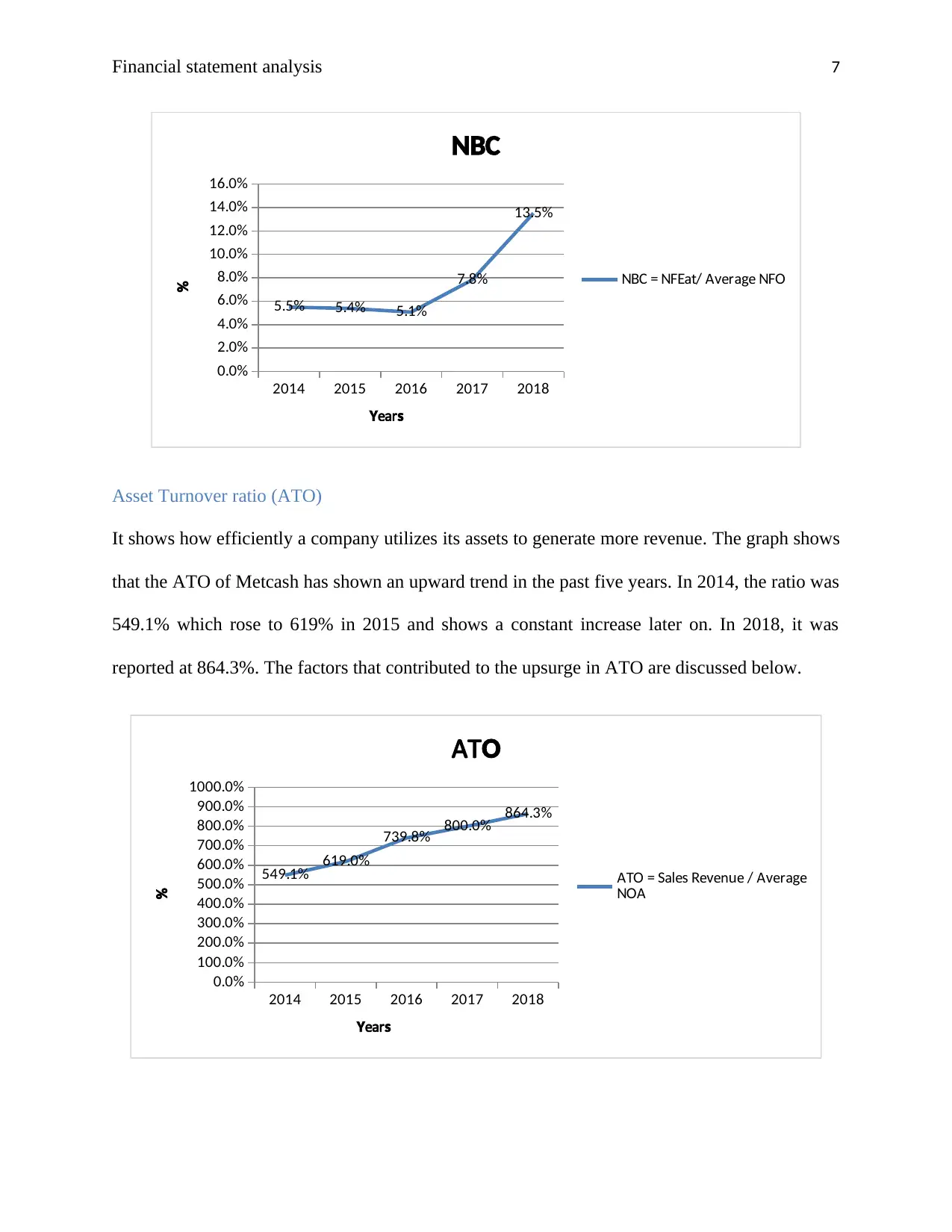
Financial statement analysis 7
2014 2015 2016 2017 2018
0.0%
2.0%
4.0%
6.0%
8.0%
10.0%
12.0%
14.0%
16.0%
5.5% 5.4% 5.1%
7.8%
13.5%
NBC
at A era eNBC = NFE / v g NFO
earY s
%
Asset Turnover ratio (ATO)
It shows how efficiently a company utilizes its assets to generate more revenue. The graph shows
that the ATO of Metcash has shown an upward trend in the past five years. In 2014, the ratio was
549.1% which rose to 619% in 2015 and shows a constant increase later on. In 2018, it was
reported at 864.3%. The factors that contributed to the upsurge in ATO are discussed below.
2014 2015 2016 2017 2018
0.0%
100.0%
200.0%
300.0%
400.0%
500.0%
600.0%
700.0%
800.0%
900.0%
1000.0%
549.1% 619.0%
739.8% 800.0% 864.3%
ATO
AT ale e en e A era eO = S s R v u / v g
ANO
earY s
%
2014 2015 2016 2017 2018
0.0%
2.0%
4.0%
6.0%
8.0%
10.0%
12.0%
14.0%
16.0%
5.5% 5.4% 5.1%
7.8%
13.5%
NBC
at A era eNBC = NFE / v g NFO
earY s
%
Asset Turnover ratio (ATO)
It shows how efficiently a company utilizes its assets to generate more revenue. The graph shows
that the ATO of Metcash has shown an upward trend in the past five years. In 2014, the ratio was
549.1% which rose to 619% in 2015 and shows a constant increase later on. In 2018, it was
reported at 864.3%. The factors that contributed to the upsurge in ATO are discussed below.
2014 2015 2016 2017 2018
0.0%
100.0%
200.0%
300.0%
400.0%
500.0%
600.0%
700.0%
800.0%
900.0%
1000.0%
549.1% 619.0%
739.8% 800.0% 864.3%
ATO
AT ale e en e A era eO = S s R v u / v g
ANO
earY s
%
Paraphrase This Document
Need a fresh take? Get an instant paraphrase of this document with our AI Paraphraser
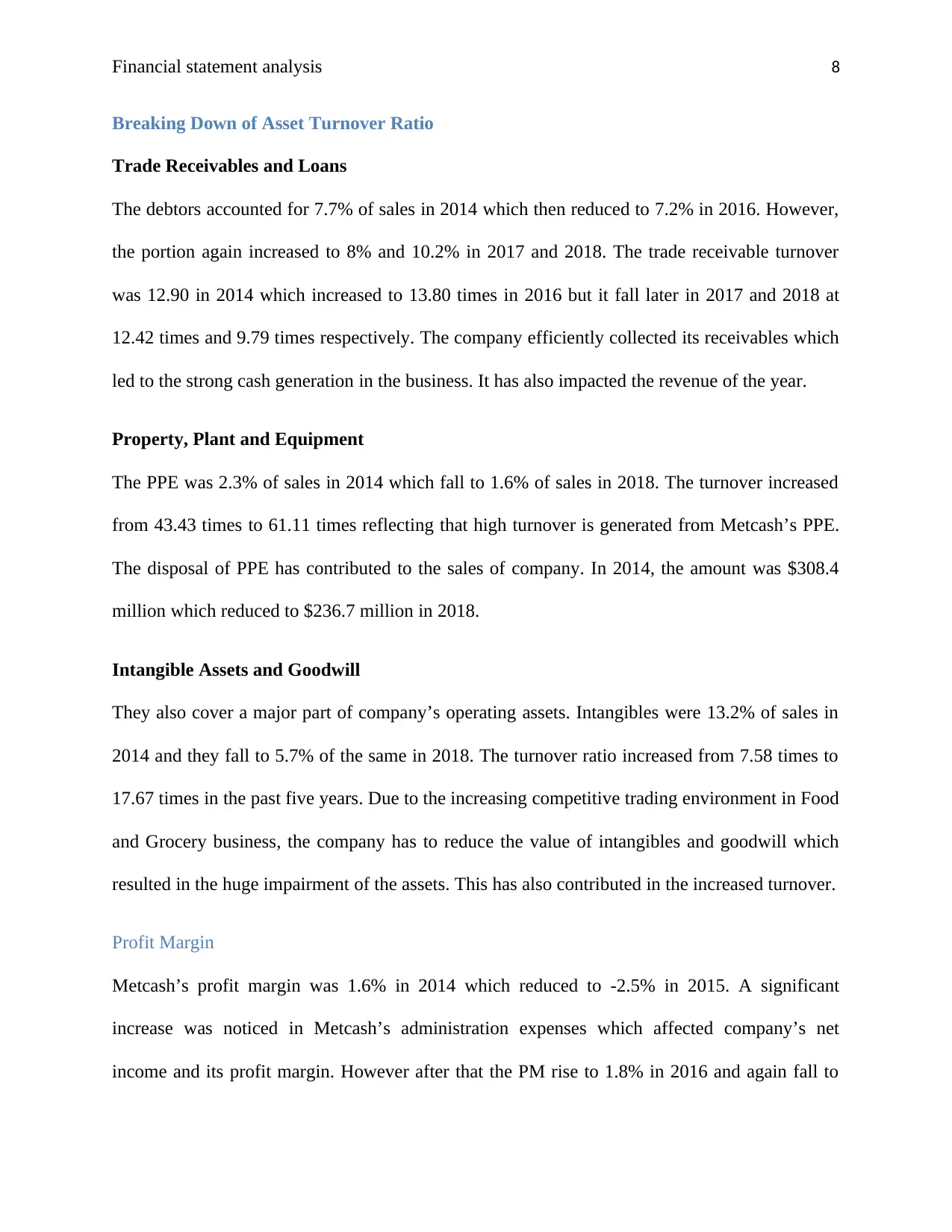
Financial statement analysis 8
Breaking Down of Asset Turnover Ratio
Trade Receivables and Loans
The debtors accounted for 7.7% of sales in 2014 which then reduced to 7.2% in 2016. However,
the portion again increased to 8% and 10.2% in 2017 and 2018. The trade receivable turnover
was 12.90 in 2014 which increased to 13.80 times in 2016 but it fall later in 2017 and 2018 at
12.42 times and 9.79 times respectively. The company efficiently collected its receivables which
led to the strong cash generation in the business. It has also impacted the revenue of the year.
Property, Plant and Equipment
The PPE was 2.3% of sales in 2014 which fall to 1.6% of sales in 2018. The turnover increased
from 43.43 times to 61.11 times reflecting that high turnover is generated from Metcash’s PPE.
The disposal of PPE has contributed to the sales of company. In 2014, the amount was $308.4
million which reduced to $236.7 million in 2018.
Intangible Assets and Goodwill
They also cover a major part of company’s operating assets. Intangibles were 13.2% of sales in
2014 and they fall to 5.7% of the same in 2018. The turnover ratio increased from 7.58 times to
17.67 times in the past five years. Due to the increasing competitive trading environment in Food
and Grocery business, the company has to reduce the value of intangibles and goodwill which
resulted in the huge impairment of the assets. This has also contributed in the increased turnover.
Profit Margin
Metcash’s profit margin was 1.6% in 2014 which reduced to -2.5% in 2015. A significant
increase was noticed in Metcash’s administration expenses which affected company’s net
income and its profit margin. However after that the PM rise to 1.8% in 2016 and again fall to
Breaking Down of Asset Turnover Ratio
Trade Receivables and Loans
The debtors accounted for 7.7% of sales in 2014 which then reduced to 7.2% in 2016. However,
the portion again increased to 8% and 10.2% in 2017 and 2018. The trade receivable turnover
was 12.90 in 2014 which increased to 13.80 times in 2016 but it fall later in 2017 and 2018 at
12.42 times and 9.79 times respectively. The company efficiently collected its receivables which
led to the strong cash generation in the business. It has also impacted the revenue of the year.
Property, Plant and Equipment
The PPE was 2.3% of sales in 2014 which fall to 1.6% of sales in 2018. The turnover increased
from 43.43 times to 61.11 times reflecting that high turnover is generated from Metcash’s PPE.
The disposal of PPE has contributed to the sales of company. In 2014, the amount was $308.4
million which reduced to $236.7 million in 2018.
Intangible Assets and Goodwill
They also cover a major part of company’s operating assets. Intangibles were 13.2% of sales in
2014 and they fall to 5.7% of the same in 2018. The turnover ratio increased from 7.58 times to
17.67 times in the past five years. Due to the increasing competitive trading environment in Food
and Grocery business, the company has to reduce the value of intangibles and goodwill which
resulted in the huge impairment of the assets. This has also contributed in the increased turnover.
Profit Margin
Metcash’s profit margin was 1.6% in 2014 which reduced to -2.5% in 2015. A significant
increase was noticed in Metcash’s administration expenses which affected company’s net
income and its profit margin. However after that the PM rise to 1.8% in 2016 and again fall to
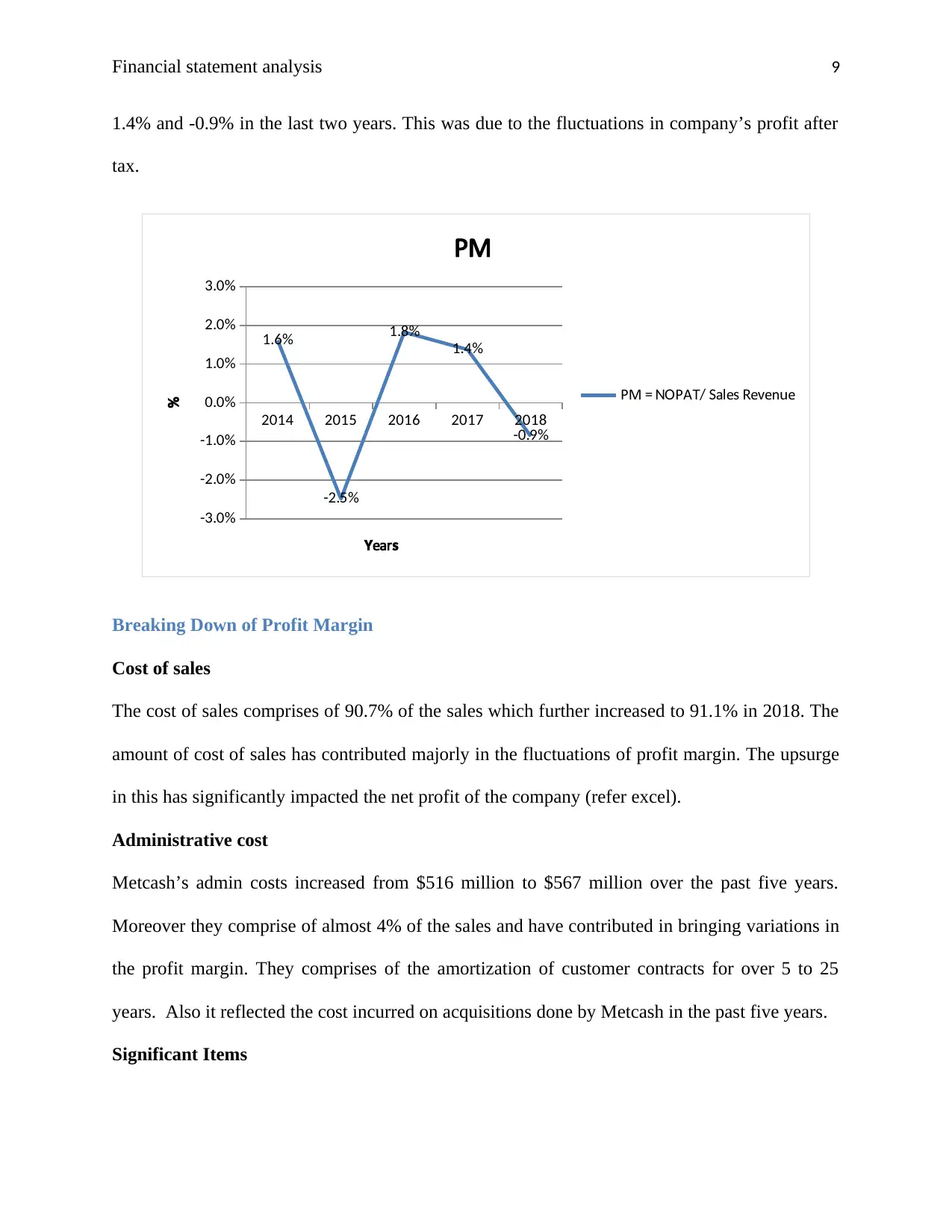
Financial statement analysis 9
1.4% and -0.9% in the last two years. This was due to the fluctuations in company’s profit after
tax.
2014 2015 2016 2017 2018
-3.0%
-2.0%
-1.0%
0.0%
1.0%
2.0%
3.0%
1.6%
-2.5%
1.8%
1.4%
-0.9%
PM
PM PAT ale e en e= NO / S s R v u
earY s
%
Breaking Down of Profit Margin
Cost of sales
The cost of sales comprises of 90.7% of the sales which further increased to 91.1% in 2018. The
amount of cost of sales has contributed majorly in the fluctuations of profit margin. The upsurge
in this has significantly impacted the net profit of the company (refer excel).
Administrative cost
Metcash’s admin costs increased from $516 million to $567 million over the past five years.
Moreover they comprise of almost 4% of the sales and have contributed in bringing variations in
the profit margin. They comprises of the amortization of customer contracts for over 5 to 25
years. Also it reflected the cost incurred on acquisitions done by Metcash in the past five years.
Significant Items
1.4% and -0.9% in the last two years. This was due to the fluctuations in company’s profit after
tax.
2014 2015 2016 2017 2018
-3.0%
-2.0%
-1.0%
0.0%
1.0%
2.0%
3.0%
1.6%
-2.5%
1.8%
1.4%
-0.9%
PM
PM PAT ale e en e= NO / S s R v u
earY s
%
Breaking Down of Profit Margin
Cost of sales
The cost of sales comprises of 90.7% of the sales which further increased to 91.1% in 2018. The
amount of cost of sales has contributed majorly in the fluctuations of profit margin. The upsurge
in this has significantly impacted the net profit of the company (refer excel).
Administrative cost
Metcash’s admin costs increased from $516 million to $567 million over the past five years.
Moreover they comprise of almost 4% of the sales and have contributed in bringing variations in
the profit margin. They comprises of the amortization of customer contracts for over 5 to 25
years. Also it reflected the cost incurred on acquisitions done by Metcash in the past five years.
Significant Items
⊘ This is a preview!⊘
Do you want full access?
Subscribe today to unlock all pages.

Trusted by 1+ million students worldwide

Financial statement analysis 10
The value was highest at $638.8 million in 2015 and later it reached to $380 million in 2018. The
items enclosed the impairment and written down of goodwill and other intangible assets. The
upsurge in the value of significant items has brought down the margin in both the years that is
2015 and 2018 (refer excel).
Cash Flow Analysis
Solvency Ratios
These ratios show the overall liquidity position of the company. It can be interpreted from the
graph that the current ratio of Metcash has shown an upward trend whereas the quick ratio
declines later in 2018. In 2015, the CR was 1.19 which reduced to 1.14 in 2016. It again
increased to 1.21 in 2017 and further reduced to 1.19 in 2018. On the other hand, the QR was
0.69 in 2014 which later on rose to 0.80 in 2018. This was due to the constant increase in current
assets and liabilities of Metcash. The cash ratio and OCF ratio has been fluctuating since past
five years. In starting cash ratio was 0.05 in 2015 which reduced to 0.02 in 2016 and again
increased to 0.08 in the recent year. The same goes with OCF ratio as it was 0.14 in 2015 that
reduced to 0.11 in 2016 which further changed to 0.18 and 0.14 in 2017 and 2018. Overall the
solvency of Metcash has increased during the past years (Metcash Limited. 2016). Fluctuating
cash and cash equivalents has created many variations in cash ratio.
The value was highest at $638.8 million in 2015 and later it reached to $380 million in 2018. The
items enclosed the impairment and written down of goodwill and other intangible assets. The
upsurge in the value of significant items has brought down the margin in both the years that is
2015 and 2018 (refer excel).
Cash Flow Analysis
Solvency Ratios
These ratios show the overall liquidity position of the company. It can be interpreted from the
graph that the current ratio of Metcash has shown an upward trend whereas the quick ratio
declines later in 2018. In 2015, the CR was 1.19 which reduced to 1.14 in 2016. It again
increased to 1.21 in 2017 and further reduced to 1.19 in 2018. On the other hand, the QR was
0.69 in 2014 which later on rose to 0.80 in 2018. This was due to the constant increase in current
assets and liabilities of Metcash. The cash ratio and OCF ratio has been fluctuating since past
five years. In starting cash ratio was 0.05 in 2015 which reduced to 0.02 in 2016 and again
increased to 0.08 in the recent year. The same goes with OCF ratio as it was 0.14 in 2015 that
reduced to 0.11 in 2016 which further changed to 0.18 and 0.14 in 2017 and 2018. Overall the
solvency of Metcash has increased during the past years (Metcash Limited. 2016). Fluctuating
cash and cash equivalents has created many variations in cash ratio.
Paraphrase This Document
Need a fresh take? Get an instant paraphrase of this document with our AI Paraphraser
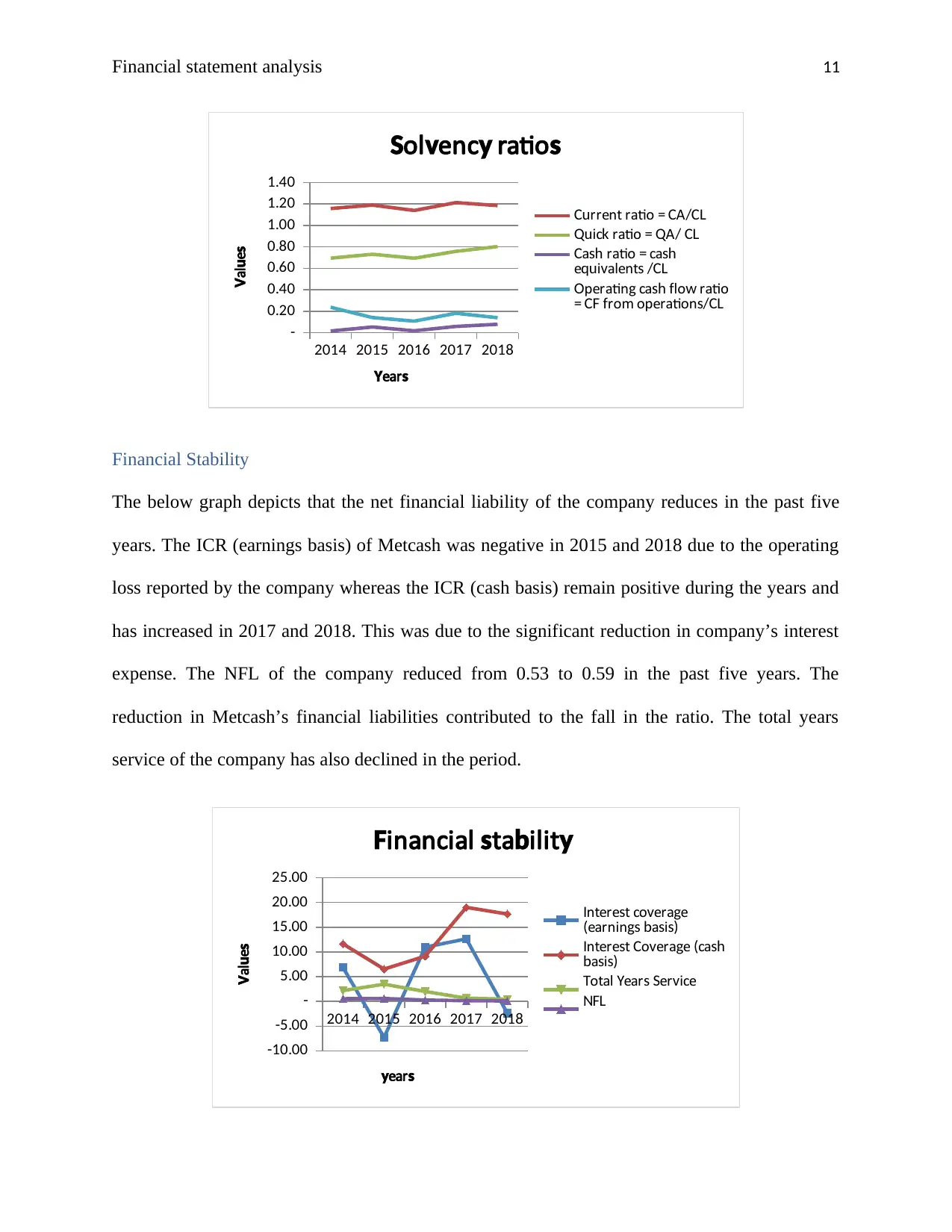
Financial statement analysis 11
2014 2015 2016 2017 2018
-
0.20
0.40
0.60
0.80
1.00
1.20
1.40
ol enc ratioS v y s
rrent ratio ACu = C /CL
ic ratio AQu k = Q / CL
a ratio caC sh = sh
e i alentqu v s /CL
peratin ca lo ratioO g sh f w
rom operation= CF f s/CL
earY s
al eV u s
Financial Stability
The below graph depicts that the net financial liability of the company reduces in the past five
years. The ICR (earnings basis) of Metcash was negative in 2015 and 2018 due to the operating
loss reported by the company whereas the ICR (cash basis) remain positive during the years and
has increased in 2017 and 2018. This was due to the significant reduction in company’s interest
expense. The NFL of the company reduced from 0.53 to 0.59 in the past five years. The
reduction in Metcash’s financial liabilities contributed to the fall in the ratio. The total years
service of the company has also declined in the period.
2014 2015 2016 2017 2018
-10.00
-5.00
-
5.00
10.00
15.00
20.00
25.00
inancial ta ilitF s b y
ntere t co era eI s v g
earnin a i( gs b s s)
ntere t o era e caI s C v g ( sh
a ib s s)
Total ear er iceY s S v
NFL
eary s
al eV u s
2014 2015 2016 2017 2018
-
0.20
0.40
0.60
0.80
1.00
1.20
1.40
ol enc ratioS v y s
rrent ratio ACu = C /CL
ic ratio AQu k = Q / CL
a ratio caC sh = sh
e i alentqu v s /CL
peratin ca lo ratioO g sh f w
rom operation= CF f s/CL
earY s
al eV u s
Financial Stability
The below graph depicts that the net financial liability of the company reduces in the past five
years. The ICR (earnings basis) of Metcash was negative in 2015 and 2018 due to the operating
loss reported by the company whereas the ICR (cash basis) remain positive during the years and
has increased in 2017 and 2018. This was due to the significant reduction in company’s interest
expense. The NFL of the company reduced from 0.53 to 0.59 in the past five years. The
reduction in Metcash’s financial liabilities contributed to the fall in the ratio. The total years
service of the company has also declined in the period.
2014 2015 2016 2017 2018
-10.00
-5.00
-
5.00
10.00
15.00
20.00
25.00
inancial ta ilitF s b y
ntere t co era eI s v g
earnin a i( gs b s s)
ntere t o era e caI s C v g ( sh
a ib s s)
Total ear er iceY s S v
NFL
eary s
al eV u s
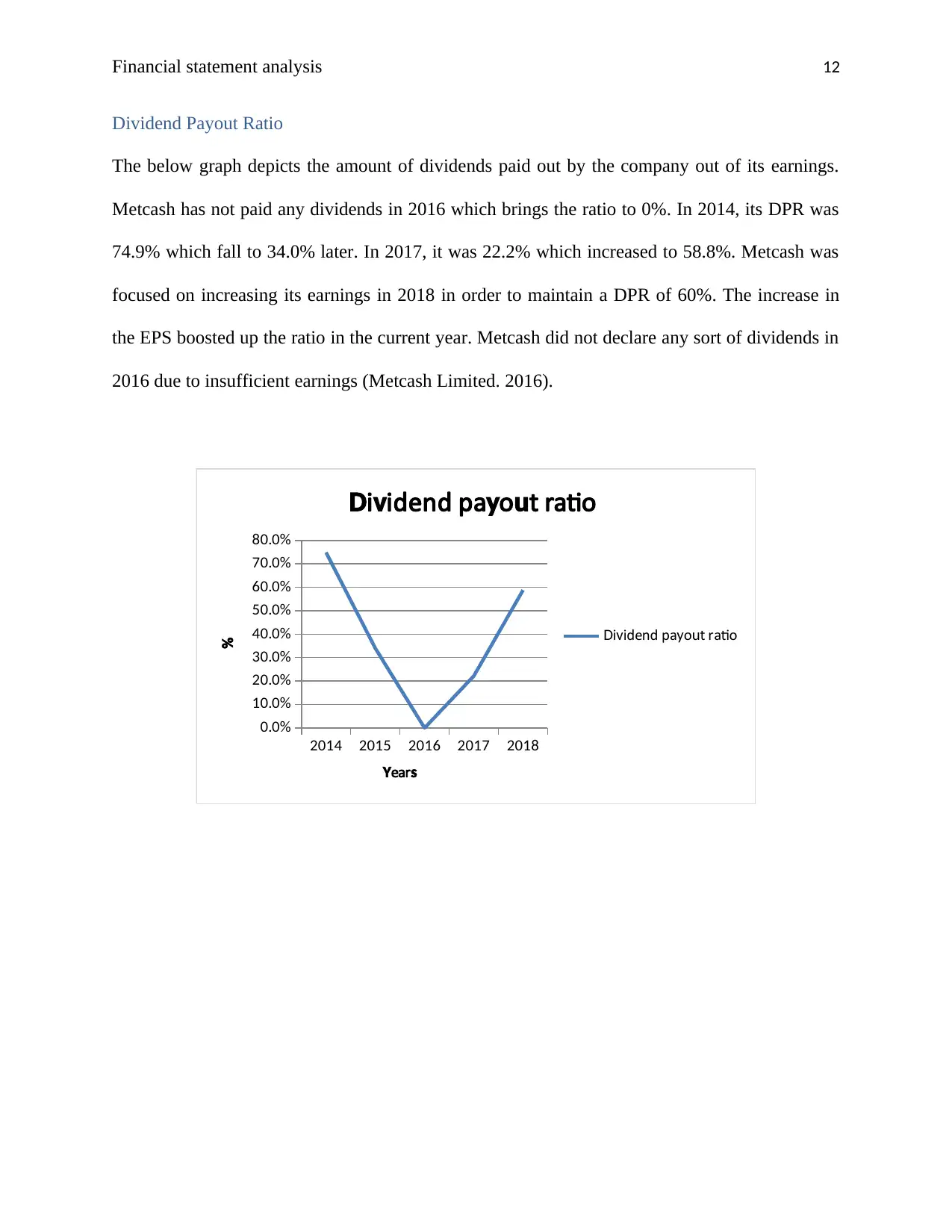
Financial statement analysis 12
Dividend Payout Ratio
The below graph depicts the amount of dividends paid out by the company out of its earnings.
Metcash has not paid any dividends in 2016 which brings the ratio to 0%. In 2014, its DPR was
74.9% which fall to 34.0% later. In 2017, it was 22.2% which increased to 58.8%. Metcash was
focused on increasing its earnings in 2018 in order to maintain a DPR of 60%. The increase in
the EPS boosted up the ratio in the current year. Metcash did not declare any sort of dividends in
2016 due to insufficient earnings (Metcash Limited. 2016).
2014 2015 2016 2017 2018
0.0%
10.0%
20.0%
30.0%
40.0%
50.0%
60.0%
70.0%
80.0%
i idend pa o t ratioD v y u
i idend pa o t ratioD v y u
earY s
%
Dividend Payout Ratio
The below graph depicts the amount of dividends paid out by the company out of its earnings.
Metcash has not paid any dividends in 2016 which brings the ratio to 0%. In 2014, its DPR was
74.9% which fall to 34.0% later. In 2017, it was 22.2% which increased to 58.8%. Metcash was
focused on increasing its earnings in 2018 in order to maintain a DPR of 60%. The increase in
the EPS boosted up the ratio in the current year. Metcash did not declare any sort of dividends in
2016 due to insufficient earnings (Metcash Limited. 2016).
2014 2015 2016 2017 2018
0.0%
10.0%
20.0%
30.0%
40.0%
50.0%
60.0%
70.0%
80.0%
i idend pa o t ratioD v y u
i idend pa o t ratioD v y u
earY s
%
⊘ This is a preview!⊘
Do you want full access?
Subscribe today to unlock all pages.

Trusted by 1+ million students worldwide
1 out of 18
Related Documents
Your All-in-One AI-Powered Toolkit for Academic Success.
+13062052269
info@desklib.com
Available 24*7 on WhatsApp / Email
![[object Object]](/_next/static/media/star-bottom.7253800d.svg)
Unlock your academic potential
Copyright © 2020–2025 A2Z Services. All Rights Reserved. Developed and managed by ZUCOL.




